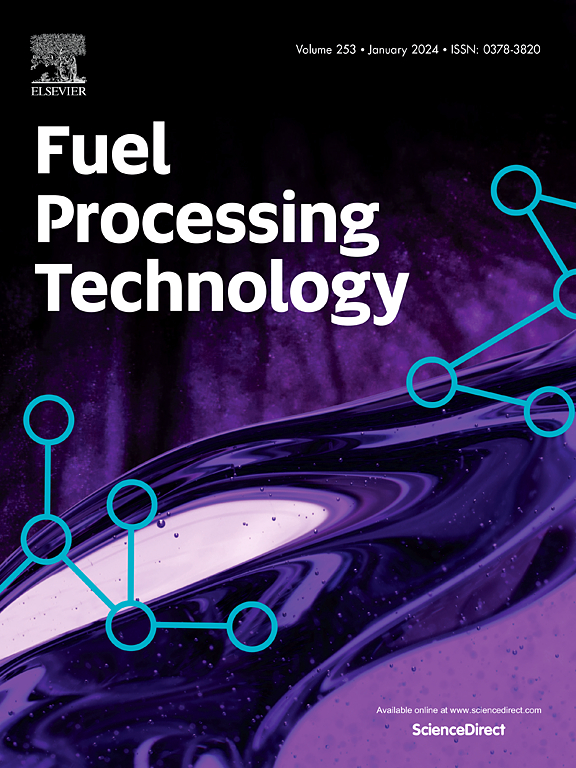A comparison study and multi-objective optimization of a DICI engine fueled with petroleum diesel and Fischer-Tropsch diesel
IF 7.7
2区 工程技术
Q1 CHEMISTRY, APPLIED
引用次数: 0
Abstract
Fischer-Tropsch diesel (FT100) from indirect coal-to-liquid is a promising alternative fuel for diesel engines due to its potential of improved emissions and enhanced engine performances. The combustion and emission characteristics of a direct injection compression ignition (DICI) engine fueled with FT100 and petroleum diesel (PD100) are systematically investigated under different injection timing (IT), common-rail pressure (Pcr) and brake mean effective pressure (BMEP). The experimental results show that, with the same engine control parameters, FT100 exhibits better fuel economy, milder combustion and lower soot emission compared to PD100. To achieve higher efficiency and cleaner combustion, further optimizations of control strategy for the FT100 engine are conducted. First, mathematical models for fuel economy, brake specific NOx (BSNOx) and soot are constructed by back propagation (BP) neural network. These models are fully verified for reproducibility and generalization ability. Subsequently, non-dominated sorting genetic algorithm (NSGA-II) is applied to realize multi-objective optimization of fuel economy and emissions. The results show that FT100 can operate and achieve multi-objective optimization under a wider range of IT and more decreased Pcr compared to PD100. Specifically, better fuel economy, lower BSNOx and soot emissions for FT100 could be achieved when the control parameters are set as follows: IT from 4.5 to 12.5 °CA BTDC, Pcr from 90 to 95 MPa, and BMEP from 0.725 to 0.950 MPa. Compared to PD100, the averagely optimal BSFC, BSNOx and K of FT100 could be decreased by 1.6 %, 25.3 % and 59.0 % at 0.88 MPa BMEP. This work provides a more suitable control strategy for DICI engine manufacturers using FT100, which helps to satisfy stricter emissions standards and increasing demand for sustainable fuel usage.
以石油柴油和费托柴油为燃料的DICI发动机的比较研究及多目标优化
费托柴油(FT100)是一种由煤间接制液而成的柴油发动机替代燃料,具有改善排放和提高发动机性能的潜力。系统研究了以FT100和PD100为燃料的直喷压缩点火(DICI)发动机在不同喷射正时(IT)、共轨压力(Pcr)和制动平均有效压力(BMEP)下的燃烧和排放特性。实验结果表明,在相同的发动机控制参数下,FT100比PD100具有更好的燃油经济性、更温和的燃烧和更低的烟尘排放。为了实现更高的效率和更清洁的燃烧,对FT100发动机的控制策略进行了进一步的优化。首先,利用BP神经网络建立了燃油经济性、制动特定氮氧化物(BSNOx)和烟尘的数学模型;这些模型的可重复性和泛化能力得到了充分的验证。随后,应用非支配排序遗传算法(NSGA-II)实现燃油经济性和排放的多目标优化。结果表明,与PD100相比,FT100可以在更大的IT范围和更少的Pcr下运行并实现多目标优化。具体而言,当控制参数设置为:IT从4.5到12.5°CA BTDC, Pcr从90到95 MPa, BMEP从0.725到0.950 MPa时,FT100可以实现更好的燃油经济性,更低的BSNOx和烟尘排放。与PD100相比,在0.88 MPa BMEP下,FT100的平均最佳BSFC、BSNOx和K分别降低了1.6%、25.3%和59.0%。这项工作为使用FT100的DICI发动机制造商提供了更合适的控制策略,有助于满足更严格的排放标准和日益增长的可持续燃料使用需求。
本文章由计算机程序翻译,如有差异,请以英文原文为准。
求助全文
约1分钟内获得全文
求助全文
来源期刊

Fuel Processing Technology
工程技术-工程:化工
CiteScore
13.20
自引率
9.30%
发文量
398
审稿时长
26 days
期刊介绍:
Fuel Processing Technology (FPT) deals with the scientific and technological aspects of converting fossil and renewable resources to clean fuels, value-added chemicals, fuel-related advanced carbon materials and by-products. In addition to the traditional non-nuclear fossil fuels, biomass and wastes, papers on the integration of renewables such as solar and wind energy and energy storage into the fuel processing processes, as well as papers on the production and conversion of non-carbon-containing fuels such as hydrogen and ammonia, are also welcome. While chemical conversion is emphasized, papers on advanced physical conversion processes are also considered for publication in FPT. Papers on the fundamental aspects of fuel structure and properties will also be considered.
 求助内容:
求助内容: 应助结果提醒方式:
应助结果提醒方式:


